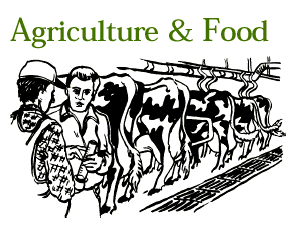 |
In Vermont, agriculture is much more than food production. It is a way
of life, a culture, and a landscape that beckons businesses, workers and
tourists. Vermont's agriculture, working landscape and rural communities
face many challenges: a global economy, low farm commodity prices,
population and development pressures, pests, and environmental pollution.
UVM, properly called the University of Vermont and State Agricultural
College, is one of many land grant colleges established under the Morrill
Act, named after Vermont's senator Justin Smith Morrill. The college,
together with the State Agricultural Experiment Station and Cooperative
Extension Service, is dedicated to providing the education--liberal and
practical--and the research and outreach needed to sustain sound,
prosperous agriculture and rural communities. |
UVM's ecological responsibilities therefore include:
- Deepening scientific understanding through experimentation, demonstration,
and integration of best agricultural practices
- Providing Vermonters access to knowledge about production and marketing of
agricultural products
- Supporting economic and ecological sustainability of Vermont agriculture
through purchasing locally produced products
- Supporting rural families and communities through education and leadership
training
At UVM, academic programs within the College of Agriculture and Life Sciences
are linked with the Vermont Agricultural Experiment Station, UVM Extension's
educational programs, four research facilities, and three academic centers.
Through a focus on the working landscape and sustainable communities, many
projects promote sustainable agriculture and economic development, bringing
together scientists, farmers, marketing experts, and consumers, including buyers
for UVM's dining halls.
The Vermont Agricultural Experiment Station
The Vermont Agricultural Experiment Station is a state-federal partnership
created to conduct applied agricultural research. In 1997 there were 161 Station
projects designed to respond to special challenges and opportunities facing
Vermont. Research programs of noted excellence have been developed in dairy
product research, sustainable agriculture, tree physiology and forest
entomology, yeast and fungal genetics, soil chemistry, integrated pest
management, microbiology and molecular genetics, and mammary gland
biology.
UVM Extension
UVM Extension is dedicated to bringing the benefits of research to Vermonters
through practical education programs concerning Vermont communities, families
and homes, farms, businesses, and the natural environment. In 1997 Extension
faculty and staff reached more than 110,000 Vermonters through workshops,
presentations, and one-on-one assistance. Extension also distributes
agriculturally related information through radio programs, newspaper articles,
and a television program, Across the Fence, reaching an estimated daily
Vermont audience of 80,000. UVM Extension has four program areas:
The Agriculture program promotes the vitality of agriculture in
Vermont. Examples of assistance provided to Vermont farmers include courses in
financial management and recycling of agricultural plastics; the Women's
Agricultural Network, a program that assists people interested in starting or
expanding agriculturally related businesses; and an integrated pest management
(IPM) program that focuses on reducing pesticides in the production of apples,
vegetables, fruits, and ornamental plants through education and research.
The Family and Community Resource and Economic Development program is
designed to help communities, families, and individuals to improve the quality
of their lives. Faculty, staff, and volunteers reach more than 6,000 Vermont
youths through 4-H programs. A sustainable rural development effort involves ten
communities in the Northeast Kingdom.
The Natural Resources and Environmental Management program focuses on
helping to sustain and enhance the quality of Vermont's natural resources. One
educational program brings together foresters, youth, farmers, loggers, teachers
and others concerned with water quality. In 1997, faculty and staff worked with
Vermonters to report sightings of the Asian long-horned beetle, a pest that
infests maple treeswhich comprise one of out of four trees in the state.
The Nutrition, Food Safety, and Health program works with low-income
families, food service professionals, farmers and others to improve food safety
and nutrition through workshops, long distance education, one-on-one meetings,
newspaper articles, and radio and television programs.
In addition to these established programs, Extension has the flexibility to
respond to natural crises. In 1997 and early 1998 Extension teams worked with
communities hit by floods and ice storms.
Research Facilities
The College of Agriculture and Life Sciences has four facilities serving as
focal points for teaching, research and outreach:
The Paul Miller Research Center on Spear Street, or UVM Farm,
has a herd of 280 Holsteins and Jerseys for animal science classes and for
research on ruminant nutrition and mastitis control. Student-run cooperatives
provide experiential learning in managing horses and a dairy operation. Research
at the farm includes experimenting with rotational grazing and with methods of
applying liquid manure and compost. An estimated 30,000 visitors come to the
center each year.
The Blasberg Horticultural Research Center in South Burlington is home
to 700 kinds of ornamental trees, shrubs, and perennials. Collections of
crabapples, apples, lilacs, small fruits, junipers, and woody plants are used
for research and education as well as by professional plant organizations and
gardening groups. A non-profit organization called Friends of the Hort Farm
promotes public involvement and advocates for preservation of the center.
The Morgan Horse Farm, a 215-acre farm in Weybridge and a National
Historic site holds a national reputation for breeding America's first light
horse, the Morgan.
The Proctor Maple Research Center serves as a living classroom for
maple producers and for students in Botany, Forestry, and Environmental Studies.
Collaborative research includes projects on lead levels in maple syrup and maple
tree physiology. This center also is the headquarters for the Vermont Forest
Ecosystem Monitoring Program, a unique collaboration of university, state, and
federal researchers conducting studies on responses of forest ecosystems to
environmental change.
Supporting these research facilities, the Agricultural Testing Lab analyzes
samples of soil, manure, and feed, and sends farmers reports recommending ways
to improve management practices.
Academic Centers
UVM's agriculturally related centers are organized to encourage
interdisciplinary research and collaboration with academic units and other
organizations. Three centers focus on rural studies, sustainable agriculture,
and food science:
Center for Rural Studies: The Center for Rural Studies (CRS) tackles
social, economic, and resource-based problems of rural people and communities in
Vermont, the U.S., and abroad. Founded in 1979, CRS provides research and
consulting services in agriculture, human services, education, rural community
and economic development, and Vermont community data. CRS is well known as a
storehouse for valuable data, including official U.S. Census materials, and the
Report Card, 36 indicators of performance for Vermont's 300 public
schools.
Center for Sustainable Agriculture: Since 1994 the Center for
Sustainable Agriculture (CSA) has worked with other agricultural programs to
protect environmental quality, reduce dependency on nonrenewable resources, and
support profitable production. CSA coordinates research and training, including
studies of pasture management, sheep and goat dairy, and water quality
protection. The Center also has an internship program linking students with
farmers.
Center for Food Science: In 1996 UVM, working in partnership with the
Vermont Technology Council, created the Center for Food Science to promote
sustainable job creation and economic development in the Vermont food industry,
with a focus on the specialty food sector.
In addition, a UVM faculty member coordinates the U.S. Department of
Agri-culture's Northeast program in Sustainable Agriculture Research and
Education, which funds $2.15 million in grants.
Food Services
In an effort to promote Vermont agricultural products, faculty and students
at UVM have recently begun to work with Marriott Education Services, which
provides food services on campus, to increase the quantity of Vermont products
served. Marriott purchases baked goods, meats, and dairy products locally, and
requires its produce distributor to provide local produce whenever available.
Following the recommendations of its Food Services Committee, Marriott has
upgraded its menus and improved its vegan, vegetarian, and heart-healthy
options.
Current & Future Efforts
- Research methods to grow fruits and vegetables organically or with minimal
pesticides
- Develop indicators of environmental quality, (e.g. soil, water and air
quality, population pressures, land use) through a collaborative process with
state agencies and other organizations
- Increase the number of jobs in the Vermont food processing sector to
foster sustainable rural communities
- Expand efforts to educate students about food choices for personal
wellness and ecological health
- Increase amount of local and organic food served at UVM
Return to
Menu

